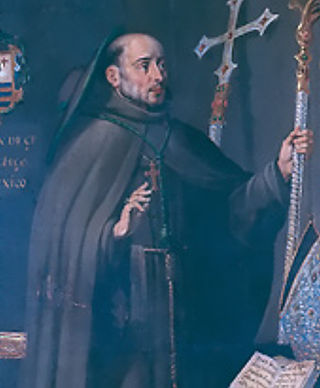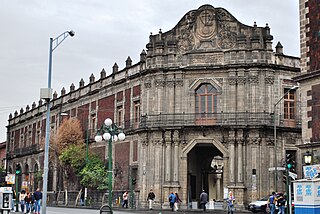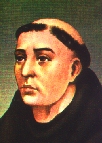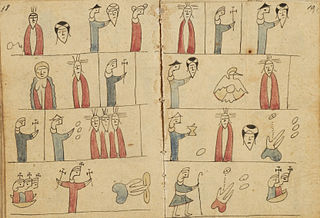Related Research Articles

The Spanish colonization of the Americas began in 1493 on the Caribbean island of Hispaniola after the initial 1492 voyage of Genoese mariner Christopher Columbus under license from Queen Isabella I of Castile. These overseas territories of the Spanish Empire were under the jurisdiction of Crown of Castile until the last territory was lost in 1898. Spaniards saw the dense populations of indigenous peoples as an important economic resource and the territory claimed as potentially producing great wealth for individual Spaniards and the crown. Religion played an important role in the Spanish conquest and incorporation of indigenous peoples, bringing them into the Catholic Church peacefully or by force. The crown created civil and religious structures to administer the vast territory. Spanish men and women settled in greatest numbers where there were dense indigenous populations and the existence of valuable resources for extraction.

Bartolomé de las Casas, OP was a Spanish clergyman, writer, and activist best known for his work as a historian and social reformer. He arrived in Hispaniola as a layman, then became a Dominican friar. He was appointed as the first resident Bishop of Chiapas, and the first officially appointed "Protector of the Indians". His extensive writings, the most famous being A Short Account of the Destruction of the Indies and Historia de Las Indias, chronicle the first decades of colonization of the West Indies. He described the atrocities committed by the colonizers against the indigenous peoples.

Juan de Zumárraga, OFM was a Spanish Basque Franciscan prelate and the first Bishop of Mexico. He was also the region's first inquisitor. He wrote Doctrina breve, the first book published in the Western Hemisphere by a European, printed in Mexico City in 1539.

Bernardino de Sahagún was a Franciscan friar, missionary priest and pioneering ethnographer who participated in the Catholic evangelization of colonial New Spain. Born in Sahagún, Spain, in 1499, he journeyed to New Spain in 1529. He learned Nahuatl and spent more than 50 years in the study of Aztec beliefs, culture and history. Though he was primarily devoted to his missionary task, his extraordinary work documenting indigenous worldview and culture has earned him the title as “the first anthropologist." He also contributed to the description of Nahuatl, the imperial language of the Aztec Empire. He translated the Psalms, the Gospels, and a catechism into Nahuatl.

The Mexican Inquisition was an extension of the Spanish Inquisition into New Spain. The Spanish conquest of the Aztec Empire was not only a political event for the Spanish, but a religious event as well. In the early 16th century, the Reformation, the Counter-Reformation, and the Inquisition were in full force in most of Europe. The Catholic Monarchs of Castile and Aragon had just conquered the last Muslim stronghold in the Iberian Peninsula, the kingdom of Granada, giving them special status within the Catholic realm, including great liberties in the conversion of the native peoples of Mesoamerica. When the Inquisition was brought to the New World, it was employed for many of the same reasons and against the same social groups as suffered in Europe itself, minus the Indigenous to a large extent. Almost all of the events associated with the official establishment of the Palace of the Inquisition occurred in Mexico City, where the Holy Office had its own major building. The official period of the Inquisition lasted from 1571 to 1820, with an unknown number of individuals prosecuted.
Sebastián Ramírez de Fuenleal was bishop of Santo Domingo and president of the Real Audiencia of Santo Domingo from 1528 to 1531. He was also president of the second Real Audiencia of Mexico from January 10, 1531, to April 16, 1535. Later he was a member of the Council of the Indies.
Alonso de Maldonado Diez de Ledesma, was a Spanish lawyer and a member of the second Real Audiencia of Mexico, which governed New Spain from January 10, 1531 to April 16, 1535. He was also president of the first Real Audiencia of Guatemala, and in that capacity interim governor of Guatemala from 1536 to September 15, 1539. He was governor of Guatemala a second time, from 1542 to 1548.

The Catholic Church during the Age of Discovery inaugurated a major effort to spread Christianity in the New World and to convert the indigenous peoples of the Americas and other indigenous peoples. The evangelical effort was a major part of, and a justification for, the military conquests of European powers such as Portugal, Spain, and France. Christian missions to the indigenous peoples ran hand-in-hand with the colonial efforts of Catholic nations. In the Americas and other colonies in Asia, and Africa, most missions were run by religious orders such as the Franciscans, Dominicans, Augustinians, and Jesuits. In Mexico, the early systematic evangelization by mendicants came to be known as the "Spiritual Conquest of Mexico".
Pedro de Córdoba OP (c.1460–1525) was a Spanish missionary, author and inquisitor on the island of Hispaniola. He was first to denounce the Spanish system known as the Encomienda, which amounted to the practical enslavement of natives of the New World, for the abuses that it engendered.

Alonso de Molina was a Franciscan priest and grammarian, who wrote a well-known dictionary of the Nahuatl language published in 1571 and still used by scholars working on Nahuatl texts in the tradition of the New Philology. He also wrote a bilingual confessional manual for priests who served in Nahuatl-speaking communities.

The Colegio de Santa Cruz in Tlatelolco, Mexico City, is the first and oldest European school of higher learning in the Americas and the first major school of interpreters and translators in the New World. It was established by the Franciscans on January 6, 1536 with the intention, as is generally accepted, of preparing Native American boys for eventual ordination to the Catholic priesthood. Students trained in the Colegio were important contributors to the work of Franciscan Bernardino de Sahagún in the creation of his monumental twelve-volume General History of the Things of New Spain, often referred to as the Florentine Codex. The failure of the Colegio had long-lasting consequences, with scholar Robert Ricard saying that "[h]ad the College of Tlatelolco given the country even one [native] bishop, the history of the Mexican Church might have been profoundly changed."

Toribio of Benavente, also known as Motolinía, was a Franciscan missionary who was one of the famous Twelve Apostles of Mexico who arrived in New Spain in May 1524. His published writings are a key source for the history and ethnography of the Nahuas of central Mexico in the immediate post-conquest period as well as for the challenges of Christian evangelization. He is probably best known for his attacks on the Dominican defender of the rights of the indigenous peoples, Bartolomé de las Casas, who criticized the Conquest. Though agreeing with Las Casas's criticism of the abuses of the conquistadors, he did not agree with the wholesale condemnation of the Spanish Conquest, as well as criticisms of the Franciscan practice of baptism en masse of the indigenous people of the new world. Due to these differences he went on to vilify Las Casas.

Antonio Valeriano was a colonial Mexican, Nahua scholar and politician. He was a collaborator with fray Bernardino de Sahagún in the creation of the twelve-volume General History of the Things of New Spain, the Florentine Codex, He served as judge-governor of both his home, Azcapotzalco, and of Tenochtitlan, in Spanish colonial New Spain.

Antonio de Montesinos or Antonio Montesino, OP was a Spanish Dominican friar who was a missionary on the island of Hispaniola. With the backing of Pedro de Córdoba and his Dominican community at Santo Domingo, Montesinos was the first European to publicly denounce the enslavement and harsh treatment of the indigenous peoples of the island. His censure initiated an enduring struggle to reform the Spanish conduct towards all indigenous people in the New World. Montesinos' outspoken criticism influenced Bartolomé de las Casas to head the humane treatment of Indians movement.

Martín de Valencia was born in Valencia de Don Juan, in the bishopric of Oviedo, Spain, ca. 1474. He died Tlalmanalco, Mexico, 21 March 1534. He was a Spanish Franciscan missionary, leader of the Twelve Apostles of Mexico, the first group of mendicants in New Spain.

The Twelve Apostles of Mexico, the Franciscan Twelve, or the Twelve Apostles of New Spain, were a group of twelve Franciscan missionaries who arrived in the newly-founded Viceroyalty of New Spain on May 13 or 14, 1524 and reached Mexico City on June 17 or 18, with the goal of converting its indigenous population to Christianity. Conqueror Hernán Cortés had requested friars of the Franciscan and Dominican Orders to evangelize the Indians. Despite the small number, it had religious significance and also marked the beginning of the systematic evangelization of the Indians in New Spain.
Pedro de Betanzos was a Spanish Franciscan missionary and linguist.

The Catholic Church in Latin America began with the Spanish colonization of the Americas and continues up to the present day.

Protector of the Indians was an administrative office of the Spanish colonies that deemed themselves responsible for attending to the well-being of the native populations by providing detailed witness accounts of mistreatment in an attempt to relay their struggles and a voice speaking on their behalf in courts, reporting back to the King of Spain. The establishment of the administration of the Protector of the Indians is due in part to Bartolomé de las Casas – the first Protector of the American Indians, and Fray Francisco Jimenez de Cisneros, the great Cardinal Regent of Spain. Throughout this era, the King of Spain gained information regarding the treatment of native peoples through Bartolomé de las Casas and Fray Francisco Jimenez de Cisneros. Bartolomé de las Casas was one of the first Europeans to set foot into the new hemisphere. He later dedicated his life to ending the harsh treatment of Indigenous Americans. The institution of the Protectors of the Indians rested on the idea that rulers should appoint officials to defend, both within and outside of the courts of justice, individuals who were less favored.

Fray Jacobo de Testera or Jacobo de Tastera was a Franciscan Friar of the 16th century who worked as a missionary to the indigenous peoples of New Spain. Born into a noble family in Bayonne, France he entered the Franciscan order around 1500 and went to Seville where he eventually became palace priest of Charles V. In 1527 he was recruited by Fray Antonio de Ciudad Rodrigo to go to Mexico where he arrived in 1529.
References
- 1 2 Rodríguez.
- ↑ Robert Ricard, The Spiritual Conquest of Mexico p. 22.
- ↑ cited in Ricard, Spiritual Conquest, p. 53.
- ↑ Ricard, Spiritual Conquest. Translated by Lesley Byrd Simpson. Berkeley: University of California Press 1966, p. 90
- ↑ Ricard, Spiritual Conquest p. 215. Ricard's work was originally published in 1933, so whether the information is still current is not known.
- ↑ Georges Baudot, Utopia and History in Mexico: The First Chronicles of Mexican Civilization, 1520-1569. Translated by Bernard R. Ortiz de Montellano and Thelma Ortiz de Montellano. Boulder: University of Colorado Press 1995, p.107-08.
- ↑ Ricard, Spiritual Conquest, p. 90
- ↑ Ricard, Spiritual Conquest p. 226 citing Joaquín García Icazbalceta, ed. Códice Franciscano, Nueva colección de documentos para la historia de México. Mexico, 1886-1892, vol. 2, p. 71.
- ↑ Ricard, Spiritual Conquest p. 130.
- ↑ Ricard, Spiritual Conquest p. 105